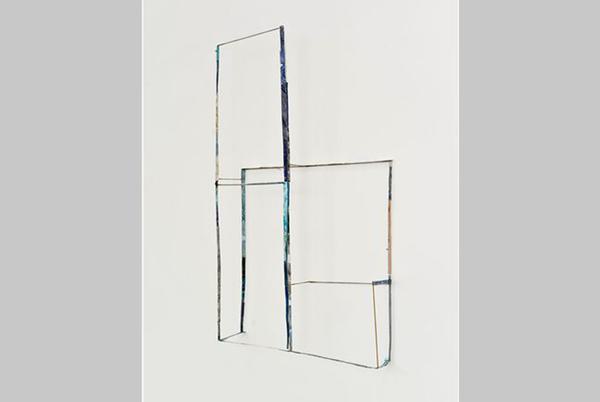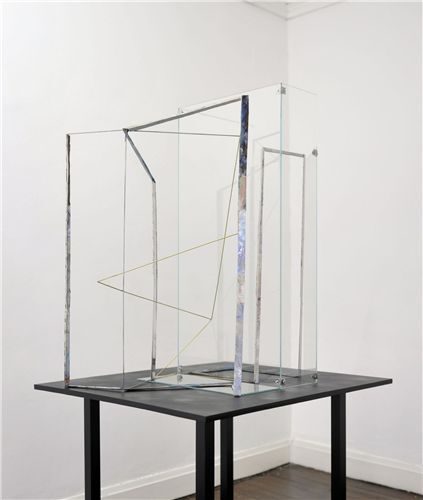Sara Barker selected by Emma Dean (2013)

Sara Barker, Story of a House, 2012. Stainless steel round bar, aluminium sheet, various paints, 119 x 73 x 15 cm. Credit: Courtesy The Artist; Mary Mary, Glasgow
BALTIC curator Emma Dean profiles Glasgow School of Art graduate Sara Barker. Her thin, linear sculptures appear to be drawings in space, and make reference to Modernist sculpture and literature
Sara Barker’s linear sculptures are made from a range of industrial and synthetic materials including aluminium, steel, cement, Perspex, ceramic and paint.
Thin frames of painted metal intersect and loop, their slender forms angled and curved. At first glimpse the works appear fragile and precariously balanced. However, each is carefully engineered and held together with just the right amount of rivets and bolts to make it stable.
Barker studied painting at Glasgow School of Art and is interested in the looseness and gesture of painting and drawing, although her process is one of reduction and economy. Working with large expanses of aluminium in the studio, she paints onto the surface with gouache, watercolour and oils, and cuts away at the material. Narrow strips of metal are then assembled into grid-like formations, the rigid structures often revealing flashes of blue, pink, green. In some works the painted surfaces have more prominence and there are larger areas of colour. Patches of canvas and filling compound add richness and texture.
The works vary in scale, from delicate wall reliefs to larger standing structures. The sharp metal contours provide a frame offering different viewpoints of other works installed in the space, or through doorways and openings. Barker does this with a carefully considered placement of work. Citing Modernist literature as an early inspiration, particularly the writers Doris Lessing, Emily Dickinson, Virginia Woolf and May Sarton, she is interested in literary depictions of the room. Her works often respond to a specific place or space; the walls, floors and proportions of an interior. Barker is also interested in the compositions of Henri Matisse, his use of colour and form, and how his line carves up the proportions of the painting. She also draws from the world around her, from an old photograph or a memory.
The titles Barker gives to her sculptures reference literary and art historical sources, providing the viewer with a useful steer in reading the work. ‘The Blue Woman’ (2008), is inspired by a Yiannis Ritsos poem, ‘Woman at a Window’ (2012), is titled after Caspar David Friedrich’s painting of a woman gazing out of a window of 1822. Both have a close relationship with the female figure. ‘La Leçon de Piano’ (2010) takes its title from a Matisse painting of 1916. Other works have titles which are more open and suggestive such as ‘Words Are Form’ (2010) or ‘Washable colour’ (2012). Sometimes, as Barker describes, a work will ‘attach’ itself to a title, and will gain meaning from doing so.

Sara Barker, A certain slant of night, 2012.
Aluminium & steel sheet, various paints, glass, painted mahogany table, 176 x 96.5 x 84 cms. Courtesy The Artist; Mary Mary, Glasgow
Recent structures incorporate new materials such as cement, brass and Shellac, cast objects and soldered metal joins. Mahogany table tops and handmade brackets hold the metal frames. Wall-based works spill onto the floor. Larger freestanding sculptures made with mirrors and sheets of glass have a direct relationship to the viewer and the body. Barker’s new works are made of more robust materials, the linear forms more elongated. But although there is a subtle shift in form and process, she still maintains the systems of making and reduction of her earlier work.
Barker does not always know what final form the work will take, but she has confidence in the materials she tests and explores. Each repetitive gesture, each brush stroke, cut or arrangement of form, becomes part of a routine. Her work is continually evolving, with uncertain outcomes. However, the process of making is always evident, and the stillness, control and materiality of her sculptures is consistently elegant and compelling.
Emma Dean (Curator, BALTIC, Gateshead) 2013.
About Sara Barker
Born in Manchester (1980), Sara Barker lives and works in Glasgow. Recent exhibitions include the solo shows, Woman at a window, Stuart Shave/Modern Art, London; Mary Mary at 45 Alexandra Park Street, Glasgow (both 2012) and Images, Mary Mary, Glasgow (2010).
Group exhibitions include GAK, Bremen (2013); Tracing the Century: Drawing from Tate Collection, Tate Liverpool; A House of Leaves. Second Movement, David Roberts Art Foundation, London; Drawing: Sculpture, Leeds Art Gallery, Leeds; Studio 58: Women Artists in Glasgow Since WWII, Mackintosh Museum, Glasgow School of Art (all 2012); Frauenzimmer, Museum Morsbroich, Leverkusen, Germany (2011); Base: Object, Andrea Rosen Gallery, New York (2008).
Upcoming exhibitions include Drawing: Sculpture, The Drawing Room, London (February); The Geometry of Things – Markus Amm / Sara Barker / Robin Watkins, GAK, Bremen (March), and a solo exhibition at Mary Mary, Glasgow in September.
Sara Barker is represented by Mary Mary, Glasgow
About Emma Dean
Emma Dean is a curator at BALTIC Centre for Contemporary Art in Gateshead. She was previously Head of Exhibitions at MK Gallery, Milton Keynes. Emma has worked on a wide range of exhibitions, projects and publications, including Turner Prize-nominated exhibitions by Phil Collins and Cathy Wilkes, survey presentations of work by Marcel Broodthaers, Gilberto Zorio, James Lee Byars, Marcus Coates, Daria Martin and Anna Barriball, first major UK solo exhibitions by Pae White, Roger Hiorns, Carlos Bunga, Phillip Allen, Carlos Amorales, Adrian Paci, Polly Apfelbaum and Gerard Byrne, and offsite commissions with Ivan and Heather Morison and Liliane Lijn. Before MK Gallery, Emma was Assistant Curator at Modern Art Oxford, and also worked at the Pitt Rivers Museum and Christ Church Picture Gallery.
These biographies were written in 2013 as part of the Open Frequency programme. For the most current information, please visit:
Open Frequency (2004–2014)
This profile was part of Open Frequency, an Axis programme that highlighted emerging developments in contemporary art practice across the UK. Artists were selected and profiled by leading curators, artists, and writers, offering unique insights into the practices shaping contemporary art at the time. These archives remain a valuable resource for understanding the trajectory of some of the most exciting artists of the period.
Helping Artists Keep Going
Axis is an artist-led charity supporting contemporary visual artists with resources, connection, and visibility.


